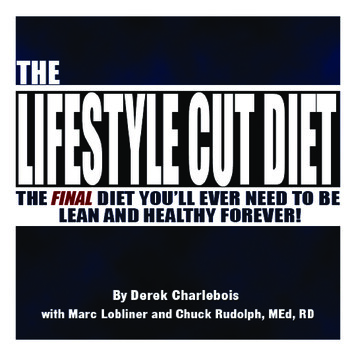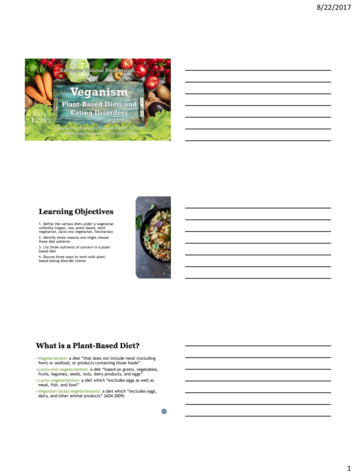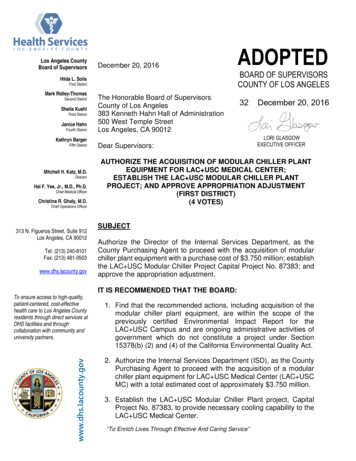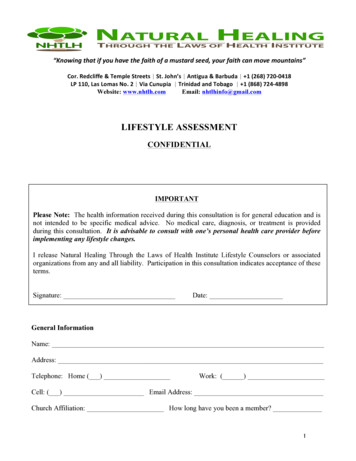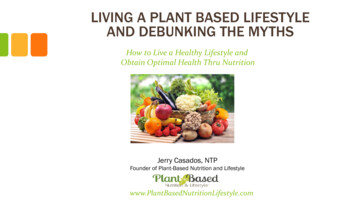
Transcription
LIVING A PLANT BASED LIFESTYLEAND DEBUNKING THE MYTHSHow to Live a Healthy Lifestyle andObtain Optimal Health Thru NutritionJerry Casados, NTPFounder of Plant-Based Nutrition and Lifestylewww.PlantBasedNutritionLifestyle.com
About MeJerry Casados, Nutrition Therapy Practitioner (NTP) NTP Diploma from Nutrition Therapy Institute, Denver Certificate in Plant-Based Nutrition from Cornell University and The T.Colin Campbell Foundation Certified Instructor for Dr. McDougall’s Starch Solution—a scientificallybased program successfully used by Dr. John McDougall for over fortyyears to help patients regain their lost health and appearances
My Health JourneyWhy I Changed to a Whole Food, Plant-Based Diet
My Health Journey2002 Diagnosed: Heart Disease (High Cholesterol, High Blood Pressure) Medications: Lipitor (cholesterol) and 3 blood pressure medicationsFebruary 2007 EBT Heart Scans (2002 & 2007) - showed progression of heart diseasefrom 2002-2007 Nuclear Stress Test (2007) – showed coronary artery calcification My Physician & Cardiologist Recommendation: angiogram I Declined Recommendation for the Angiogram Procedure
My Health JourneyWhy decline the Angiogram?Reason: Learned information in the pastKnowledge is PowerDefinition of Knowledge: Awareness or familiarity gained by experience of a fact orsituation.When we educate ourselves, we learn new things that we were previously unawareof. This gives us the ability to make better decisions, come up with more evolved andintelligent thoughts, improve the lives of ourselves and those around us, and thusmakes us more valuable people overall.
Decided on lifestyle approach insteadOatmealFollowed The McDougall’s Program : 12 Days toDynamic Health(book by Dr. John McDougall, M.D.*)VSAngiogram
My Health JourneyMarch 2007 Started a whole food, plant-based diet for 30 daysBiomarkers improved (cholesterol -20 and BP dropped) - still on medsLost 8 poundsDoctor said, “Keep up the good work!”June 2007 - Attended Dr. McDougall 10-day Live-In Program Off medications (June 2007) Lost 4 pounds, cholesterol and BP normal Other participants in 10-day program had similar results: Average weight loss was 3.1 pounds while eating unrestricted amountsof food Average cholesterol reduction was 22 mg/dL An average decrease of 18/11 mmHg in blood pressure in patients withhypertension (140/90 or greater) Nearly 90% of patients were able to get off blood pressure and diabeticmedications
My Health JourneyToday Reversing heart disease Regained my health 35 pounds lighter Maintaining a consistent weight (my setpoint) Cholesterol below normal & BP normal Dr. McDougall: My mentor and hero Proud to be a ‘Star McDougaller’ Enjoying my new career as a nutritionist helping people develop a healthy lifestyleand seeing the remarkable results they achieve in their overall health and wellbeing. It truly is gratifying to see that people can take control of their health.
Lifestyle Choices Do Lifestyle Choices Matter? What makes up a healthy lifestyle?
What is a Healthy Lifestyle?Meditation, Yoga, Walking Plant-Based DietDiet / NutritionRelieve StressFamily, Friends,CommunityWalking, Biking, Yoga JustMove!Love and SupportMovement
Lifestyle and Nutrition Nutrition is an important component of a healthy lifestyle. The food choices you make affect your weight, how yourbody functions, your overall health and well-being. The food we eat has one of greatest effects on determiningthe quality and length of our lives.Lifestyle Matters !
Lifestyle and Nutrition Do you want to feel better with more energy? Do you want to improve, stabilize, or even reverse a chronic conditionsuch as heart disease, high cholesterol, diabetes, or high bloodpressure? Do you want to lose weight? Would you like to take fewer medications? Are you open to changing your diet if it could really improve your health?If the answer is “YES" to any of these questions, then a whole food,plant-based lifestyle (diet) may be for you.
What are some of the health benefits of a plant-based diet? Lower cholesterol, blood pressure, and blood sugar Prevent and Reverse heart disease Prevent and Reverse Type 2 Diabetes Healthier weight and weight loss Lower risk of cancer May slow the progression of certain types of cancer Improved symptoms of rheumatoid arthritis Fewer medications Lower food costs Good for the environment Improved Digestion and Bowel Movement Much more Best of all, a plant-based diet can be a tasty and enjoyable way to eat!
What is a low-fat, whole food, plant-based diet? A whole-food, plant-based diet is centered on whole, unrefined plants. It’s a diet based on fruits, vegetables, tubers (all potatoes) and starchy vegetables, wholegrains, and legumes. It excludes of all animal foods, including red meat, poultry, dairy products, eggs, and fish –all of which provide toxic levels of fat, cholesterol, protein and, very often, infectious agentsand harmful chemicals. Also, ALL oils are excluded from the diet, including olive oil, safflower oil, coconut oil andcorn oil. Oils, which are nothing more than liquid fat, increase body fat stores (weight gain),has been shown to depress immune function, and can contribute to most common chronicdiseases. In a recent study1, scientists found that heating up vegetable oils led to therelease of high concentrations of chemicals called aldehydes, which have been linked toillnesses including cancer, heart disease and dementia. You can add of plenty of spices to enhance the flavor of food and use simple sugars and saltsparingly.1. Martin Grootveld, a professor of bioanalytical chemistry and chemical pathology, Study: Cooking with vegetable oils releases toxic cancercausing chemicals
What are the New Food Groups?The foundation of the diet is based-onstarchy vegetables and grains, which willbe the centerpiece of your meals, with theaddition of fresh or frozen yellow, greenand orange vegetables and fruits.Chart shows the food groups for a plantbased or starch-based diet.FOOD GROUPStarchesExamples of Food Choices Non-Starchy Vegetables Fruit – all types Potatoes, sweet potatoes, yamsWhole grains, such as brown rice, barley,oatmeal, wheat, quinoa, corn and milletLegumes (beans (all types), peas, and lentils)Squashes, such as acorn, butternut, buttercup,summer squashes, and pumpkinCarrots, collard greens, bok choy, broccoli,Brussels sprout, cauliflower, celery, eggplant,green beans, kale, onions, spinach, lettuce, garlic,leeks, zucchini, celeryApples, Oranges, Peaches, Passion fruit, Papaya,Mango, Kiwifruit, Grapes, Cherries, Blueberries,Strawberries, Cantaloupe, Pineapples, Bananas,Blueberries
The New Food Groups: Nutrition Profile These foods are scientifically proven to provide optimal, balanced nutrition, andtherefore are ideal for all human beings Because of their high complex-carbohydrate content and low-fat content, theyare also ideal weight-loss foods Also, these foods contain immune-boosting antioxidantsOnly plants have these antioxidant vitamins such as C, E, and beta carotene.Animal foods are either exceedingly low or devoid of the antioxidants.
2%(SAD)10%Added Fats & Oils, Sugars,Refined Grains, Fast FoodMeat, Dairy, Eggs, Fish, Poultry,Seafood.Cholesterol, a PRIMARY sourceof saturated fat.88%25%63%
What About the Environment?What does it take to make a 1 LB Hamburger?Source: Earth Save International
What About the Environment?
What About the Environment?Methane gas from animal agriculture is responsible for 51percent of greenhouse gas emissions, more than the combinedexhaust from all transportation.Source: Cowspiracy
Plant-Based Myths and Nutrients in Plants Debunking Plant-Based Diet Myths Do Plants Have Complete Nutrition?
Plant-Based MythsMyth 1 - Plants don’t have enough protein - Where Do You Get Your Protein?
Plant-Based MythsMyth 1 - Plants don’t have enough protein - Where Do You Get Your Protein?Protein is one of the most misunderstood and, consequently, most abusedsubstances in the food supply.All plant foods contain protein and all the protein you need. Also, all plantfoods contain "complete proteins," meaning that they contain all the"essential" amino acids, which are the building blocks of proteins. Thismeans that you will get all the protein – as well as all the amino acids – youneed on a diet composed exclusively of plant foods. Plants are the only foodseaten by elephants, horses, and hippos, and all three have no troublegrowing all the muscle, bone, and tissue they need.For example, broccoli contains 45% protein from its calories and beanscontains 9% to 30% depending on the variety.
Plant-Based MythsMyth 1 - Plants don’t have enough protein - Where Do You Get Your Protein?
Plant-Based Myths: ProteinExcess Protein Causes Diseases of Over-nutritionUnlike fat, protein cannot be stored in the body!Consumption of more than what the body needs:1) Overworks the liver and kidneys and can cause accumulation of toxic proteinbyproducts2) The excess protein must be removed and finally eliminated through the kidneys aspart of the urine3)These unneeded amino acid wastes (proteins): Can injure the structures of the kidneys Overtime, diets high in protein may promote the development of kidney stonesand other health issues such as bone loss, osteoporosis, kidney damage
Plant-Based Myths: ProteinProtein Intake Varies WorldwideProtein (grams/day)Western Diet*Protein % of Calories100 – 16015% - 35%Rural Asia40 – 608% - 14%**McDougall Diet30 - 807% - 15%200 - 40030% - 70%Low-Carb Diet*Calculations based on 2000 calories/day for adult**The McDougall Program is the protocol I follow in my nutrition practice
Plant-Based MythsMyth 2 - Where do I get my calcium?All plant foods contain generous amounts of calcium. The most healthfulcalcium sources are green leafy vegetables and legumes (beans). Forexample, broccoli, brussels sprouts, collards, kale, mustard greens,swiss chard, and other greens are loaded with highly absorbable calciumand a host of other healthful nutrients. The exception is spinach, whichcontains a large amount of calcium but tends to hold onto it verytenaciously, so that you will absorb less of it.Calcium Absorption of Selected Foods1One uiceWholeMilkSkim MilkGross Calcium19 mg94 mg83 mg128 mg350 mg291 mg302 mgCalcium Absorption64.8 %40.9 %52.6 %57.8 %37 %32.1 %32.1 %Calories60424825120150861 - Weaver, Connie, "Dietary calcium: Adequacy of a vegetarian diet,", American Journal of Clinical Nutrition, 59-suppl, 1994, p1238S-41S
Plant-Based Myths: Calcium
Calcium
Plant-Based MythsMyth 3 - Complex-Carbohydrates (Starches) – Don’t Make You FatCarbohydrates - our primary source of energy for our body. They supply 4 calories per gram, the same as protein. Fat hasmore than twice as many calories (9 per gram) Plus, there is abundance of fiber in complex-carbohydrates, andfiber has no calories, because it isn’t absorbed by the body
Plant-Based Myths: Carbohydrates The science shows after eating, the complex carbohydrates found in starches, such as rice or beans,are digested into simple sugars in the intestine and then absorbed into the bloodstream where theyare transported to the cells in the body in order to provide for energy. These long chains of glucose orsugar must be broken down inside your intestine before they can be used as fuel. The process of digesting these complex sugars is slow and methodical, providing a steady stream offuel pumped into your bloodstream as long-lasting energy. This is what keeps your energy levels highthrough-out the day. Carbohydrates (sugars) consumed in excess of the body’s daily needs can be stored as glycogen in themuscles and liver. The total storage capacity for glycogen is about two pounds. Carbohydrates (complex) consumed in excess of our need and beyond our limited storage capacity arenot readily stored as body fat. Instead, these excess carbohydrate calories are burned off as heat (aprocess known as facultative dietary thermogenesis) or used in physical movements not associatedwith exercise.
Carbohydrates – Yes Even the Potato!
Plant-Based Myths: CarbohydratesSimple-Carbohydrates Empty Calories Simple carbs are refined, processed carbohydrate foods that have had all or most of their naturalnutrients and fiber removed, except for the simple carbohydrate—thus they are called “empty calories. Most baked goods, white breads, white pastas, snack foods, candies, soft drinks and non-diet softdrinks fit into this category. Bleached, enriched wheat flour and white sugar - along with an array ofartificial flavorings, colorings, and preservatives are the most common ingredients used to make 'badcarb' foods. The goal is to limit or avoid your intake of simple carbs and increase you starch (complexcarbohydrates). So, whenever possible you want to choose ‘Good Carbohydrates’ and try to avoidrefined and processed foods.
Plant-Based Myths: CarbohydratesStarches are Comfort FoodJust think of starches as comfort food, and everyone usually has a favorite comfort food. With astarched-based diet you can have these same comfort foods you like but made without the meat ordairy but still have the same great flavors. Such foods as: a spinach lasagna, minestrone soup,bean and rice burrito, a pot roast without the roast, mashed potatoes and gravy with roastedvegetables and corn, and homemade three bean chili and much, much more.
Plant-Based Myths: Carbohydrates (Starch) Starch is Clean FuelStarches are very low in fat (1% to 8% of their calories)Contains no cholesterolDo not grow human pathogens (salmonella, E. Coli, etc.) – come from animalsources or cross-contiminationDo not store poisonous chemicals like DDT, methyl mercury Starch is Complete NutritionStarches are plentiful in protein ( 6% to 28% of their calories)Contains a proper array of vitamins and mineralsFull of dietary fiberVery energy satisfying “comfort food” (fills you up)
Plant-Based Myths: CarbohydratesAll large populations of trim, healthy people, throughout verifiable human history, have obtained thebulk of their calories from starch. Here are some examples:Caloric Engines of Human CivilizationBarley– Middle East for 11,000 yearsCorn (maize) – North, Central, and South America for 7,000 yearsLegumes– Americas, Asia, and Europe for 6,000 yearsMillet– Africa for 6,000 yearsOats– Middle East for 11,000 yearsPotatoes– South America (Andes) for 13,000 yearsSweet Potatoes – South America and Caribbean for 5,000 yearsRice– Asia for more than 10,000 yearsRye– Asia for 5,000 yearsWheat– Near East for 10,000 years
Blue ZonesBlue Zones is a concept used to identify a demographic and/or geographicarea of the world where people live measurably longer lives.In these “Blue Zones” they found that people reach age 100 at rates 10 timesgreater than in the United States. Their diet is over 90% whole foods, plantbased.
Blue ZonesDan Buettner is a National Geographic Fellow and New York Times best-selling author.He wrote about Blue Zones in 2005 for National Geographic and has written a couple ofbooks about them. In his research he actually visited all the Blue Zones and spent timeand lived with the people in these blue zones and offers an explanation, based onempirical data, historical data and first hand observations, as to why these populationslive healthier and longer lives.Dan Buettner identifies longevity hotspots or Blue Zones in: Okinawa (Japan) Sardinia (Italy) Nicoya (Costa Rica) Icaria (Greece) Loma Linda, California among the Seventh-day Adventists
Blue ZonesBlue Zones Average Diet1: Plant slant – over 90% plants and plant productsHigh Carb Diet - 65% carbohydrates, 20% fat, 15% proteinFish and eggs 2-3 times per weekMeat 5 times per monthDaily handful of nutsDaily cup of beansWater, tea, coffee and wine (evening)1. Dan Buettner, Author, longevity expert and National Geographic Explorer, Lessons for Living Longer From the PeopleWho've Lived the Longest
Blue Zones Okinawans: The island of Okinawa, in Japan, is the best place on earth for healthy aging. TheOkinawans have: Diet consists mostly of sweet potatoes, rice, vegetables, some fish and no dairy products More people over 100 years old per 100,000 population than anywhere else in the world The lowest death rates from cancer, heart disease and stroke (the top three killers in theUS) The highest life expectancy for both males and females over 65 Females in Okinawa have the highest life expectancy in all age groups Seventh-Day Adventists are strict vegetarians, who consume mainly grains, legumes, fruits, andvegetables, and as a result have a lower incidence of heart disease and colon cancercompared to the general population.
Nutrients in PlantsWhat About Vitamins and Minerals ?
Vitamins and Minerals in PlantsVitamins Most Americans eating the Standard American Diet (SAD) are vitamin and mineral deficient becauseof the food (animal-based) they eat. That is why many take supplements to fill the real or perceiveddeficiency. Whole food plants have all the nutrients that the human body requires: carbohydrates, protein, fat,vitamins, minerals, fiber, and sufficient calories. So, there should be no need to add supplementswhen following a whole food plant-based diet. The two vitamins that are not produced by plants are vitamins D and B12. You can get vitamin D insome fortified cereals or from sunlight, and *B12 you can get from a supplement.*It is recommended that if you follow a plant-based diet for more than 3 years, or if you are pregnant ornursing, take five micrograms of vitamin B12 each day to ensure that they are getting an adequatesupply of the vitamin. (Both vitamins are stored in your tissues for long periods of time.)
VitaminsSome examples of good food sources for vitamins that will help you get the proper nutritional balance:VitaminAB6B12*CDEKSome Good Food SourcesCarrots, sweet potatoes, red pepper, spinach, kale, watercress, mangoes,apricots, broccoli, apples, fortified cereals, and oatmealSpinach, red bell peppers, turnip greens, garlic, cauliflower, mustard greens,banana, celery, cabbage, crimini mushrooms, asparagus, broccoli, kale,tomato, carrotsSea weed, animal-based foods (not a recommended source)Red bell peppers, parsley, broccoli, cauliflower, strawberries, romaine lettuce,lemon juice, mustard greens, Brussel sprouts, kale, papaya, kiwifruit,cantaloupe, oranges, cabbage, tomato, asparagus, cucumbers, fennel,pineapple, sweet potato, baked potato, cornSunlight, fortified cerealsSpinach, kale, mustard greens, collard greens, red bell peppers, tomato,brussel sprouts, olives, blueberries, broccoli, almonds, turnip greensSpinach, kale, mustard greens, asparagus, green beans, collard greens, redbell peppers, tomato, brussel sprouts, kidney beans, strawberries, avocado
Vitamins and Minerals in PlantsMineralsMinerals are another group of nutrients (along with vitamins) needed by the body. They have two generalbody functions: to regulate body processes, and to give the body structure.Such as: Blood Clotting, Heartbeat Maintenance of the internal pressure of body fluids Nerve responses The transport of oxygen from the lungs to the tissuesEven though they make up only a small percentage of your body—about 4 percent of your body weight –minerals are essential to life.
Vitamins and Minerals in PlantsSome examples of good food sources for minerals that will help you get the proper nutritional orusPotassiumSeleniumSodiumThiaminZincSome Good Food SourcesBasil, broccoli, collard greens, kale, kelp, cinnamon, swiss chard, cabbage,summer squash, green beans, garlic, asparagus, oranges, romaine lettuceDark green leafy vegetables, dried beans and peas, spinach, tofu, wheatgerm, whole-grain breads, iron-fortified cereal, nuts, raisinsWhole grains, legumes, kale, celery, green beans, spinach, nuts, seeds,tomato, eggplant, beets, quinoaKale, mustard greens, spinach, chard, romaine lettuce, strawberries,pineapple, maple syrup, brown rice, legumes, grapesBroccoli, asparagus, bran, corn, legumes, lentils whole grains, nuts,seeds, wheat germSweet potato, banana, baked potato, wheat germ, kidney beans, spinach,bell pepper, strawberries, tomatoes, broccoli, eggplantBrown rice, spinach, garlic, tofu, oats, asparagus, cabbage, cornSalt, sea salt, celery, beetsRomaine lettuce, asparagus, spinach, eggplant, mustard greens, brusselsprouts, celery, red bell pepper, carrot, broccoli, legumesWhole grains, legumes, nuts, seeds, lentils, mushrooms, oats, wholegrains
What is Calorie Density? How much energy (calories) is provided per unit measure of food. Usually expressedas calories per pound.Example: 1 lb. of vegetables 100 calories (approx.)1 lb. of ground beef 1000 calories (approx.) Calorie dense foods, (high in calorie density) such as fat (animal based foods) andrefined sugars, provide many calories in a small amount of food. Foods with low calorie density -- fruits, vegetables -- provide fewer total calories andgreater nutrition in a larger volume of food.All Calories Are Not Equal!
Principles of Calorie DensitySatiety1) High in Water2) High in Fiber3) High in NutrientsBulk
Principles of Calorie DensityAll Calories Are Not Equal!FATPROTEIN1 gram 9 calories1 gram 4 caloriesCARBOHYDATE1 gram 4 caloriesExamplePotato : 50 grams carbohydrate x 4 200 caloriesMeat: 50 grams of fat x 9 450 calories
Calorie Density Calorie density really is a common-sense approach to sound nutrition and isthe cornerstone of good health. It is the simplest way to lose and/or manage your weight for life: more food for fewer calories and is easy to understand and follow. by following a few simple principles, you will increase the amount offood on your plate while decreasing your overall caloric intake, allwithout ever having to go hungry. At the same time, you will be optimizing your overall nutrient intake(vitamins, minerals, fiber, protein, essential fats, etc.). Studies have shown that diets based on low calorie density foods tend to behealthier and more effective for weight management.
Principles of Calorie Density
Clinical Study Evidence
Lifestyle Heart Trial Lifestyle Heart Trial in 1990 28 heart diseased people and treatedthem with lifestyle changes only 20 heart diseased people with thestandard treatment plan suggested bydoctors for people with heart disease It was a randomized, controlled trial todetermine whether comprehensivelifestyle changes affect coronaryatherosclerosis after 1 year
Lifestyle Heart Trial - Program
Lifestyle Heart Trial - Results
Lifestyle Heart Trial1 Year Later
Clinical EvidenceOther studies have had similar results such as ones conducted by CaldwellEsselstyn Jr., MD and have repeated it (study) several times."If the truth be known coronary artery disease is a toothless paper tiger thatneed never, ever exist and if it does exist it need never, ever progress."– Dr. Caldwell Esselstyn, Jr., Author of the book "Prevent and Reverse HeartDisease".
Dietary Intervention StudyThe McDougall Program Cohort: The Largest Study of the Benefits from a Medical Dietary InterventionThe Nutrition Journal on October 14, 2014 published the results of 1,615 patients who attended theMcDougall Program in Santa Rosa, California.Important Medical Findings Achieved in Seven Days from Eating the McDougall Diet Average weight loss was 3.1 pounds while eating unrestricted amounts of food Average cholesterol reduction was 22 mg/dL An average decrease of 18/11 mmHg in blood pressure in patients with hypertension (140/90 or greater) Nearly 90% of patients were able to get off blood pressure and diabetic medicationsPlease note that the more overweight and unhealthy the persons were at the beginning of the program, themore favorable were their results were at the end. For example, when cholesterol began at over 240 mg/dL, thereduction seen was 39 mg/dL, whereas cholesterol levels at less than 150 mg/dL at the beginning experiencedan 8 mg/dL decrease in a week.
Why does Plant-Based Nutrition Heal?
Plant-Based Nutrition“Nutrition is a collective thing, a holistic idea that works in yourbody like a symphony providing nutrients packaged by nature ina single food.”T. Colin Campbell, PhD, Author of The China Study and Whole – Rethinking the Scienceof Nutrition
Plant-Based NutritionFor example, an apple, what is it about the apple that promoteshealth?Nutrients in apple: Vitamin C, vitamin K, vitamin B6, potassium, dietary fiber, andvitamin A And has smaller of amounts of many minerals like vitamin E,magnesium and a whole host of other nutrients And don’t forget all the antioxidant and phytochemicals, whichyou here about every day, how important they are in preventingchronic diseasesThe Whole is Greater Than the Sum of Its Parts!
Plant-Based NutritionSpontaneous Healing The body is always trying to heal and with a nutrient-dense diet with plant-based foods;the body repairs itself immediately even if you have any chronic disease such as heartdisease, or type-2 diabetes. For disease to progress, injury must outpace healing. Reversing disease is simply amatter of turning this scenario around. To be specific, stop the ongoing injury, which isusually self-induced. If you are healthy, you become even healthier and your body is using the nutrients toprevent any chronic disease in the future. Let the body heal itself with the right food!
2%10%Added Fats & Oils, Sugars,Refined Grains, Fast FoodMeat, Dairy, Eggs, Fish, Poultry,Seafood.Cholesterol, a PRIMARY sourceof saturated fat.88%25%63%
Optimal Diet
Optimal Diet - What’s Kind of Food Do You Eat?Steel Cut Irish OatmealPasta PrimaveraMock Tuna SaladBean & Corn EnchiladasHearty Vegetable StewCreamy Corn & PotatoChowder
Final Thoughts Empower yourself by being a good consumer when it comes toyour health be Informed. Even making small changes in your diet and lifestyle can make asignificant difference in your health and well being. Why wait for disease or diagnosis to change right now the coolthing is that people are waking up. Trust the food! There are only good side effects!IT’S THE FOOD!
"Let food be thy medicine.Let medicine be thy food." Hippocrates THANK YOU!
Live a Healthy Lifestyle andObtain Optimal Health with Plant-Based Nutrition
Sep 03, 2019 · Certified Instructor for Dr. McDougall’s Starch Solution—a scientifically based program successfully used by Dr. John McDougall for over forty years to help patients regain their lost health and appear



